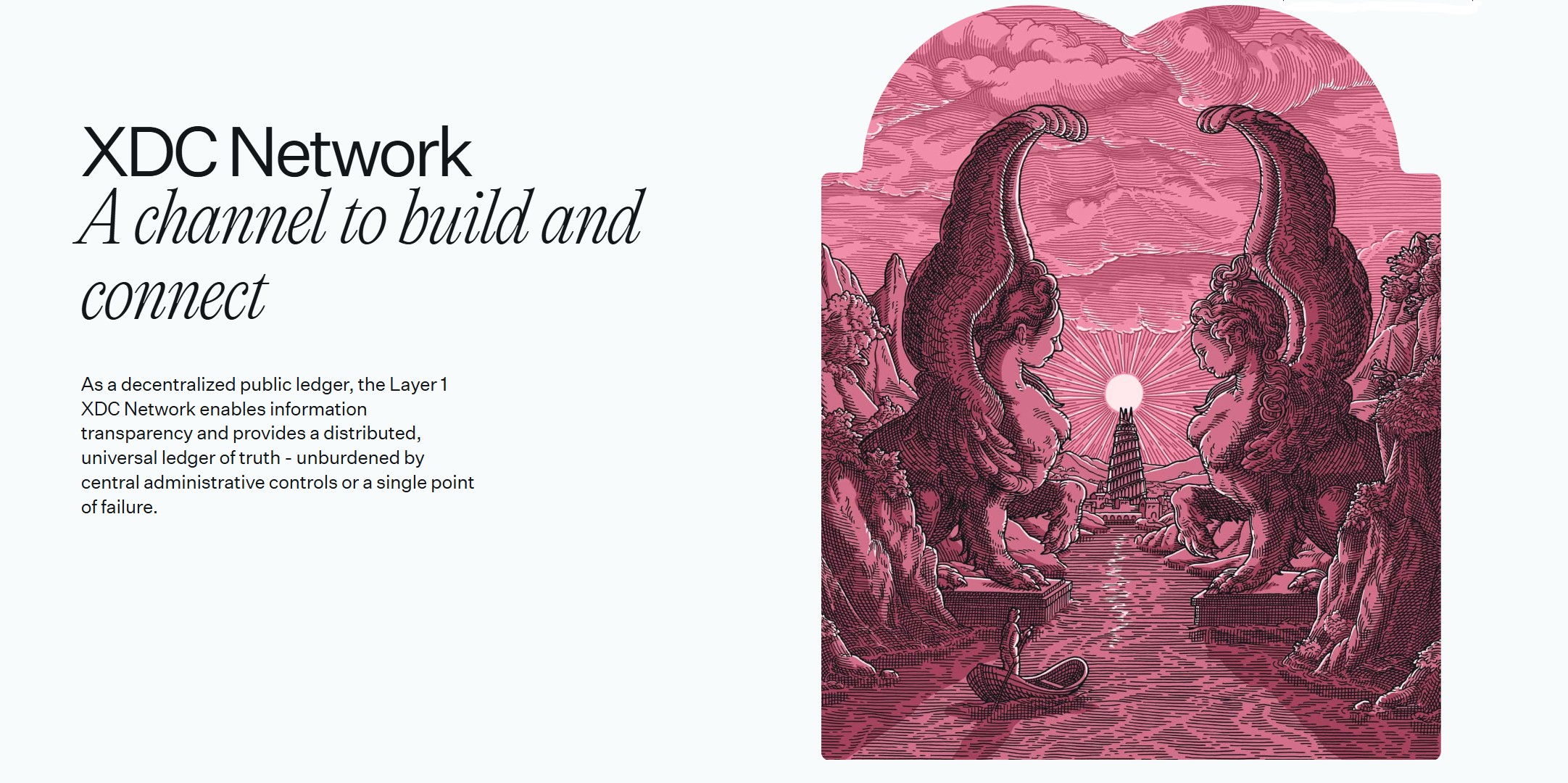XDC Price Prediction: RWA Tokenization, & Trade Finance
XDC Network is an enterprise-grade, Layer 1 blockchain designed for real-world asset (RWA) tokenization, trade finance, and ISO 20022-compliant financial messaging. It is EVM-compatible, operates on a delegated proof-of-stake (XDPoS) consensus mechanism, and offers high-speed, low-cost transactions optimized for institutional and enterprise adoption.
XDC’s primary focus is trade finance, an industry with a $5 trillion funding gap where small and medium enterprises (SMEs) struggle to access liquidity. By integrating with key global trade finance organizations such as ITFA, DNI Initiative, and the Trade Finance Distribution Initiative (TFDi), XDC Network provides a trustless, decentralized infrastructure for tokenizing invoices, letters of credit, and other financial instruments.
Beyond trade finance, XDC is a leader in RWA tokenization, hosting assets like tokenized U.S. Treasuries (USTY by Yieldteq and BlackRock) and private credit markets. The network’s cross-chain interoperability with R3 Corda and its ISO 20022 integration position it as a viable solution for institutional payments and settlement processes.
For investors in 2025 and 2030, XDC presents an opportunity as blockchain adoption in traditional finance accelerates. RWA tokenization is projected to grow into a multi-trillion-dollar market, and XDC Network’s strong foundation in regulated finance, trade finance, and digital asset tokenization makes it a potential leader in the space.
XDC Network Fundamentals
What is XDC Network?
XDC Network is an enterprise-grade Layer 1 blockchain built for trade finance and real-world asset (RWA) tokenization. It is EVM-compatible, enabling seamless smart contract deployment, and operates on a delegated proof-of-stake (XDPoS) consensus mechanism, ensuring energy efficiency and scalability. The XDC 2.0 upgrade introduces a Byzantine fault-tolerant (BFT) protocol, enhancing security, transaction finality, and network efficiency. With an average block time of 2.33 seconds and transaction costs 1/100th of Ethereum, XDC provides a high-speed, low-cost infrastructure for financial applications.
Key Use Cases & Adoption
XDC Network is a leader in RWA tokenization, enabling digital representation of U.S. Treasuries, trade finance assets, private credit, and invoices. It hosts Yieldteq’s USTY token, which tracks a BlackRock-managed U.S. Treasury ETF, making XDC a key player in the tokenized treasury market. In trade finance, XDC is integrated with major global initiatives, including ITFA, the DNI Initiative, TradeTrust, and the Trade Finance Distribution Initiative (TFDi). The SBI Group has also partnered with XDC to enhance cross-border trade solutions in the Asia-Pacific region.
XDC supports enterprise blockchain solutions, offering ISO 20022-compliant financial messaging and cross-chain interoperability through R3 Corda and Securitize, facilitating the digitization of private market securities. The network’s governance is strengthened by XDCDAO, ensuring decentralized decision-making and community-driven ecosystem development.
Decentralization & Governance: XDC’s DAO Model
XDC Network’s decentralized governance is facilitated through XDCDAO, a community-driven initiative focused on protocol upgrades, ecosystem funding, and developer support. Unlike centralized blockchain networks, XDC empowers its community to participate in governance decisions, ensuring transparency and long-term sustainability. DAO-driven initiatives such as grants, hackathons, and trade finance collaborations reinforce XDC’s decentralized ethos, making it an attractive choice for institutions seeking regulatory-compliant yet decentralized blockchain infrastructure.
Market Performance & Trading Overview
| Metric | Value |
| Current Price | $0.06736 |
| Market Cap | $1.058B |
| Trading Volume (24h) | $24.82M |
| All-Time High (ATH) | $0.1939 (Aug 2021) |
| All-Time Low (ATL) | $0.0001571 (June 2019) |
| Liquidity & Trading | High activity on Bybit, KuCoin, MEXC, Gate.io, Bitfinex |
Recent price action suggests strong support around $0.06, with resistance near $0.10–$0.12. The market structure reflects cyclical growth driven by trade finance adoption and RWA tokenization trends.
Key Catalysts for XDC Growth
Since its mainnet launch in 2019, XDC has steadily expanded its ecosystem through strategic partnerships and network upgrades. The network has grown to over 1.6 million accounts, processed 563.9 million transactions, and deployed 16,000+ smart contracts. Key institutional partnerships, including SBI Group’s expansion into the Asia-Pacific market and the integration of RWA tokenization platforms such as Tradeteq and Securitize, position XDC as a leading blockchain for regulated financial applications.
RWA Tokenization Boom
The RWA sector has seen significant expansion, growing from $105M in early 2023 to $1.47B by mid-2024. Institutional adoption is driving this trend, with BlackRock-backed USTY token offering accredited investors exposure to U.S. Treasury yield funds. Platforms like Tradeteq and Securitize are integrating XDC for on-chain private credit and asset tokenization, strengthening its role in bringing traditional finance onto blockchain.
TradFi Disruption
The global trade finance gap has widened to $5 trillion, disproportionately affecting SMEs seeking liquidity. XDC is addressing this issue by digitizing trade instruments such as invoices, letters of credit (LCs), and electronic bills of lading (eBLs), making them accessible through blockchain-based marketplaces like TradeFinex. The UK’s Electronic Trade Documents Act (ETDA), which grants legal recognition to digital trade documents, is accelerating blockchain adoption in global trade, making XDC a key infrastructure provider.
Institutional adoption
XDC’s ISO 20022-compliant messaging enables cross-border payments and financial data exchange, making it compatible with existing banking systems. The SBI XDC Network APAC initiative, in partnership with SBI Group, is driving enterprise adoption in the Asia-Pacific region by integrating smart contracts and RWA tokenization into trade finance operations. Additionally, corporate and banking partnerships with ITFA, DNI Initiative, Plug and Play, and Impel further cement XDC’s role in financial infrastructure modernization.
XDC 2.0
The XDC 2.0 upgrade introduces a BFT-based consensus mechanism (Chained Hotstuff), enhancing security, scalability, and finality. Institutional-grade subnets provide enterprises with private blockchain environments while retaining public ledger transparency. The CertiK audit has validated XDC’s security, and upcoming Ethereum Virtual Machine (EVM) upgrades will enhance Solidity smart contract support, ensuring compatibility with the latest Ethereum-based development standards.
XDC Price Prediction
XDC 2025 Price Prediction
XDC’s price trajectory in 2025 will be influenced by RWA adoption, trade finance integration, regulatory clarity, and overall market conditions. If institutional adoption accelerates and blockchain-based trade finance solutions gain widespread traction, XDC could see significant price appreciation.
| Scenario | Price Range | Key Factors |
| Bull Case | $0.25 – $0.35 | Institutional adoption of RWA tokenization, growing DeFi presence, increased regulatory clarity. |
| Base Case | $0.15 – $0.20 | Steady growth in trade finance applications, moderate expansion in staking, stable enterprise adoption. |
| Bear Case | $0.05 – $0.10 | Market downturn, sluggish adoption rates, macroeconomic uncertainties limiting investment in blockchain solutions. |
XDC 2030 Price Prediction
By 2030, RWA tokenization and trade finance digitization will likely be more mature, positioning XDC as a potential leader in the space. If mainstream institutions fully integrate blockchain for trade finance and global liquidity management, XDC could experience exponential growth. However, competition from other blockchains and evolving regulatory environments will be determining factors.
| Scenario | Price Range | Key Factors |
| Bull Case | $0.80 – $1.50+ | Widespread institutional adoption, global trade finance digitization, mainstream RWA tokenization, strong network effect. |
| Base Case | $0.40 – $0.75 | Trade finance sector growth, steady enterprise usage, increased blockchain-based settlements. |
| Bear Case | $0.15 – $0.30 | Rising competition from other networks, regulatory fragmentation, slower-than-expected adoption. |
XDC’s price in the long term depends on its ability to maintain its technological edge, expand enterprise partnerships, and navigate the evolving regulatory landscape. If it continues to lead in trade finance tokenization, it has strong potential for sustained value growth.
XDC vs. Competitors
XDC Network competes with several blockchains in the trade finance, RWA tokenization, and enterprise blockchain sectors, including Ethereum, Ripple (XRP), Algorand, and Stellar. While many networks offer smart contract capabilities and tokenization solutions, XDC differentiates itself with high efficiency, low transaction costs, and targeted trade finance integrations.
Technical & Performance Comparison
XDC utilizes Delegated Proof-of-Stake (XDPoS) with Byzantine Fault Tolerance (BFT), ensuring fast, energy-efficient transactions with minimal fees. Compared to Ethereum’s high gas fees and Bitcoin’s slow transaction times, XDC provides a cost-effective and scalable alternative. Ripple and Stellar focus on financial transactions but lack the decentralized smart contract capabilities XDC offers.
| Blockchain | Consensus | TPS (Transactions Per Second) | Avg. Fees | Energy Efficiency | Enterprise Adoption |
| XDC Network | XDPoS + BFT | 2,000+ | $0.00001 | 10M x more efficient than BTC | Strong (Trade Finance, RWA) |
| Ethereum | Proof-of-Stake | 30 (Pre-Sharding) | $2.00+ | Moderate | High (DeFi, NFTs) |
| Ripple (XRP) | XRPL Consensus + BFT | 1,500+ | $0.000001 | High | Strong (Cross-Border Payments) |
| Algorand | Pure PoS | 6,000+ | $0.001 | High | Moderate (Tokenization) |
| Stellar (XLM) | SCP | 1,000+ | $0.00001 | High | Strong (Remittances, Payments) |
Trade Finance & RWA Tokenization
XDC stands out as the only Layer 1 blockchain with direct affiliations to major trade finance organizations, including the ITFA, DNI Initiative, and TFD Initiative. Unlike Ethereum, which hosts RWA projects in a high-fee environment, XDC provides scalability, compliance support, and direct integration with financial institutions. Ripple and Stellar focus on payments but lack extensive trade finance partnerships. Algorand offers asset tokenization but has lower adoption in regulated financial markets.
Want to know how blockchain is transforming cross-border payments?
Check out this insightful post from @satz_tr on how XDC Network, Ripple, and Stellar can collaborate on fast, cheap, and efficient solutions for global finance.
A must-read for fintech fans! https://t.co/vrmAOMof8E
— XDC Community (@xdc_community) March 15, 2025
Adoption & Institutional Backing
XDC has secured partnerships with SBI Group, BlackRock-backed Securitize, and Tradeteq, reinforcing its dominance in RWA tokenization and trade finance solutions. While Ethereum leads in DeFi and NFT markets, its high fees and slower transactions make it less competitive in regulated finance. Ripple has strong adoption in cross-border settlements, but ongoing regulatory scrutiny in the U.S. limits its expansion. Stellar’s focus on remittances restricts its broader use case potential.
XDC’s unique advantage lies in low-cost, high-speed transactions tailored for real-world financial instruments, making it a leading choice for institutions looking to bridge traditional finance with blockchain technology.
Risks & Challenges
Regulatory uncertainty remains a major challenge for XDC Network, as the evolving global framework for digital assets can impact adoption and institutional participation. While the UK’s Electronic Trade Documents Act (ETDA) has provided a regulatory boost for digital trade finance, broader regulations in the EU, U.S., and Asia could either accelerate or hinder blockchain-based trade finance and RWA tokenization. Compliance with international financial regulations, including AML and KYC requirements, will be critical for XDC’s growth, particularly as institutions demand regulatory clarity before integrating blockchain solutions.
Competition from other blockchains poses another challenge. Ethereum, as the dominant smart contract platform, continues to attract enterprises due to its established developer ecosystem and institutional adoption. Algorand, Quant, and XRP are also competing for the same target market, offering enterprise-grade solutions, cross-border payment capabilities, and regulatory compliance. Algorand’s focus on financial institutions, Quant’s interoperability framework, and XRP’s deep ties to the banking sector create a competitive landscape that XDC must navigate. To maintain its edge, XDC must continue enhancing its trade finance integrations and leveraging its lower costs and efficiency advantages over Ethereum-based solutions.
Liquidity and exchange support remain key concerns for XDC’s broader adoption. While the token is actively traded on platforms like Bybit, KuCoin, MEXC, and Bitfinex, listings on major exchanges such as Binance and Coinbase would significantly improve market accessibility and institutional confidence. Greater liquidity is essential for reducing price volatility and ensuring smooth capital flow within the ecosystem. Expanding exchange listings, improving fiat on/off ramps, and deepening integration with DeFi platforms will be necessary steps for XDC to solidify its market presence.
Conclusion
XDC Network presents a compelling long-term investment case, primarily driven by its strong positioning in real-world asset (RWA) tokenization, trade finance disruption, and enterprise blockchain adoption. With the RWA sector expanding from $105 million in 2023 to $1.47 billion in 2024 and major institutions like BlackRock, Securitize, and Tradeteq integrating blockchain-based asset tokenization, XDC stands to benefit from increasing institutional interest in digital finance. Its trade finance focus, backed by affiliations with ITFA, the DNI Initiative, and TradeTrust, makes it a viable solution to the $5 trillion trade finance gap, making it an attractive choice for businesses seeking cost-efficient and scalable blockchain solutions.
Enterprise adoption further strengthens XDC’s investment case. Its ISO 20022 compliance and ability to facilitate cross-border payments provide a bridge between traditional financial systems and blockchain-based transactions. The recent expansion into the Asia-Pacific region through SBI XDC Network APAC highlights its potential to establish itself as the go-to blockchain for trade finance in a market where regulatory advancements like the UK’s ETDA are accelerating digital transformation. With the introduction of XDC 2.0, institutional-grade subnets, and enhanced security mechanisms, the network is evolving to meet enterprise demands while maintaining its low-cost and high-speed transaction advantages.
The question of whether XDC can reach $1+ by 2030 depends on adoption growth, market conditions, and regulatory developments. Under bullish scenarios, where RWAs become mainstream and institutional capital flows into blockchain-based trade finance, XDC could see valuations between $0.80 and $1.50. A base-case scenario, where adoption continues steadily but faces competition from Ethereum, Algorand, and Quant, suggests a price range of $0.40 to $0.75. In a bearish case, with regulatory roadblocks and limited institutional expansion, XDC may struggle to move beyond $0.30. While the potential for high returns exists, investors must weigh the risks of competition, liquidity constraints, and broader market sentiment when considering XDC as a long-term asset.
Ultimately, XDC’s trajectory depends on whether it can establish itself as the default blockchain for trade finance and RWA tokenization. If blockchain is to revolutionize global trade, then networks like XDC, which offer practical and regulatory-compliant solutions, will play a central role. However, technology alone does not drive adoption; strategic partnerships, regulatory alignment, and network effects do.
Frequently Asked Questions (FAQ)
What Is XDC Network (XDC)?
XDC Network is an enterprise-grade, Layer 1 blockchain designed for trade finance, real-world asset (RWA) tokenization, and ISO 20022-compliant financial messaging. It offers fast, low-cost transactions and seamless interoperability for institutional adoption.
What Makes XDC Network (XDC) Unique?
XDC stands out for its focus on trade finance, low transaction costs, energy-efficient Delegated Proof-of-Stake (XDPoS) consensus, and direct integrations with global financial institutions, including ITFA, DNI Initiative, and Tradeteq.
How to Buy XDC Network?
You can buy XDC on major cryptocurrency exchanges like Bybit, KuCoin, MEXC, and Gate.io. Simply create an account, deposit funds, and trade XDC against USDT or other supported pairs.
How Many XDC Network Tokens Are There?
XDC Network has a total supply of 37.98 billion XDC, with a circulating supply of 15.69 billion XDC as of 2025.
Is It Safe to Invest in XDC Network?
XDC Network is a well-established blockchain with enterprise adoption, strong security measures, and ongoing regulatory compliance efforts. However, like any investment, it carries risks based on market conditions and regulatory developments.
What Is the All-Time High of XDC Network?
XDC Network reached an all-time high of $0.1939 on August 21, 2021, during a bullish market cycle.
What Is the Daily Trading Volume of XDC Network?
As of 2025, XDC Network’s daily trading volume is approximately $24.82 million, reflecting active market participation across multiple exchanges.
Can XDC Reach $1?
XDC could reach $1 by 2030 if institutional adoption of RWA tokenization accelerates, trade finance digitization expands, and regulatory clarity improves.
Will XDC Reach $0.5?
XDC has the potential to reach $0.50 if trade finance adoption continues growing, institutional partnerships expand, and the overall cryptocurrency market remains bullish.







